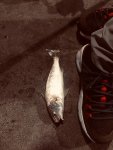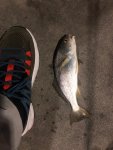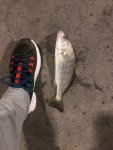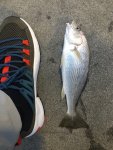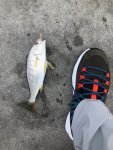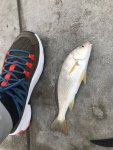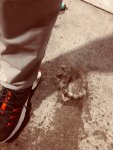Got to the pier around 5:30AM after stopping at Big Fish Bait and Tackle and loading up on live bait. I got on pack of live ghost shrimp, a bag of mussels and, a pack of live blood worms.
Set up pretty close to the breakers to start with and started fishing the live ghost shrimp on a carolina rig with a small gauge size 2 hook. I tail hooked the shrimp, fed the hook all the way through and put the tip of the hook back into the lower part of the tail of the shrimp on the underside. This was my first time fishing with live ghost shrimp.
I really liked fishing with them! They are big enough to get ignored by the bait fish but so enticing (at least today) that I got a bit within 3 minutes of casting pretty much every time. Out of the 12 shrimp I had, I landed 6 good sized yellowfin croaker and 3 small sharks (2 leopards and 1 spiny dogfish?). I missed three hook sets. I didn't see anyone around me catching anything but smelt and sardines.
Once I ran out of the ghost shrimp, I moved to mid-pier to get away from the surfers and I switched to fishing the mussels and live blood worms on a hi-lo rig. After a bigger fish broke me off, I retied with a dropshot rig with two hooks. I was able to catch 4-6 more small yellow fin croaker but had to contend with smelt stealing my bait.
I also caught a few small smelt and a sardine on a sabiki rig and hooked them to my fish finder rig. I only got one bite on that setup on a very small smelt that I had nose hooked.
I switched spots one more time and switched from fishing the north side to the south side and went a little farther down. I saw a bonito boil while I was there but could not get them to bite on a live sardine that I was fishing.
This was the first time ever at the pier that I could not get a nibble on salted shrimp that is usually my most versatile cut bait. Same went for a guy and his grandson that were fishing next to me. They were fishing fresh cut shrimp and got no bites while my rig with the mussels and live blood worms got constant attention.
I left around 1:30PM. All fish I caught were released as I've been eating lots of fish from my last trip to the jetty with DiegoGarciaWahoos (what's better than a fishing buddy that outfishes you everytime and doesn't really cook fish) and EgoNonBaptizo. Also of all the fish I've prepared food with, yellow fin croaker has so far been my least favorite. But I appreciated catching them today. They put up good fights and made my day exciting.
I'm going to try buying the live ghost shrimp a couple more times and if they continue to produce so well, I'm going to get a pump and try to learn on to harvest them myself. Any tips on that would be most appreciated!
My girl and I are going to rent a skiff on Saturday and head out to the water between the two jetties to fish.
Set up pretty close to the breakers to start with and started fishing the live ghost shrimp on a carolina rig with a small gauge size 2 hook. I tail hooked the shrimp, fed the hook all the way through and put the tip of the hook back into the lower part of the tail of the shrimp on the underside. This was my first time fishing with live ghost shrimp.
I really liked fishing with them! They are big enough to get ignored by the bait fish but so enticing (at least today) that I got a bit within 3 minutes of casting pretty much every time. Out of the 12 shrimp I had, I landed 6 good sized yellowfin croaker and 3 small sharks (2 leopards and 1 spiny dogfish?). I missed three hook sets. I didn't see anyone around me catching anything but smelt and sardines.
Once I ran out of the ghost shrimp, I moved to mid-pier to get away from the surfers and I switched to fishing the mussels and live blood worms on a hi-lo rig. After a bigger fish broke me off, I retied with a dropshot rig with two hooks. I was able to catch 4-6 more small yellow fin croaker but had to contend with smelt stealing my bait.
I also caught a few small smelt and a sardine on a sabiki rig and hooked them to my fish finder rig. I only got one bite on that setup on a very small smelt that I had nose hooked.
I switched spots one more time and switched from fishing the north side to the south side and went a little farther down. I saw a bonito boil while I was there but could not get them to bite on a live sardine that I was fishing.
This was the first time ever at the pier that I could not get a nibble on salted shrimp that is usually my most versatile cut bait. Same went for a guy and his grandson that were fishing next to me. They were fishing fresh cut shrimp and got no bites while my rig with the mussels and live blood worms got constant attention.
I left around 1:30PM. All fish I caught were released as I've been eating lots of fish from my last trip to the jetty with DiegoGarciaWahoos (what's better than a fishing buddy that outfishes you everytime and doesn't really cook fish) and EgoNonBaptizo. Also of all the fish I've prepared food with, yellow fin croaker has so far been my least favorite. But I appreciated catching them today. They put up good fights and made my day exciting.
I'm going to try buying the live ghost shrimp a couple more times and if they continue to produce so well, I'm going to get a pump and try to learn on to harvest them myself. Any tips on that would be most appreciated!
My girl and I are going to rent a skiff on Saturday and head out to the water between the two jetties to fish.
Attachments
-
305 KB Views: 16
-
313.2 KB Views: 17
-
317.8 KB Views: 16
-
374 KB Views: 15
-
464.2 KB Views: 15
-
356.8 KB Views: 16
-
364.6 KB Views: 16

